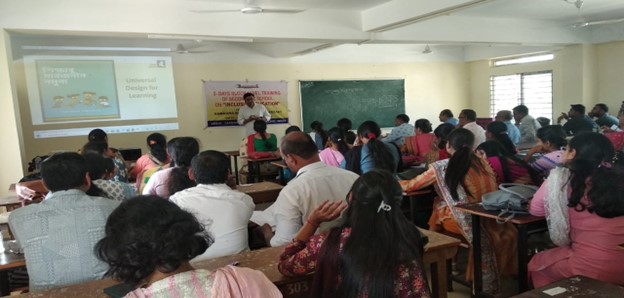


I was recently involved in conducting a series of 8 training sessions, some back-to-back, on Inclusive Education held by Samagra Shiksha Assam in different blocks of Kamrup and Kamrup (Metro) on behalf of Shishu Sarothi.
The experience was as challenging as it was inspiring and adventurous, as I got to engage and interact with many seasoned heads of schools, teachers, parents, and even Anganwadi workers.
Diversity is a natural part of our society
As we met in the crammed classrooms and hall venues and grappled with technology and PowerPoint presentations, to discuss and promote Inclusive Education (IE) and Universal Design (UDL) for Learning strategies, I saw and experienced the idea of the diversity of learners even as I talked to them about recognizing it in their classrooms, with the school heads and teachers.
I witnessed the diverse perspectives of the teachers towards the very idea of inclusive education. Many believed that children with disability would do better in ‘special’ schools and would lag behind in mainstream schools. Some teachers looked at children with disability through the lens of charity and sympathy. Some older teachers close to retirement seemed jaded and were not motivated to learn anything new.
They were my samples of ‘diversity’ in a classroom, and a test for me to practice and prove that Inclusive Education is about “all” students and that UDL is a strategy that can be used to help “minimize barriers and maximize learning”.
Over two days allotted to me in these training programs, I talked and discussed these issues with my ‘diverse’ groups and very often concluded with almost everyone agreeing, that inclusive education is important for an inclusive society. The lens of charity would be discarded for another lens that saw and embraced a rights-based perspective of equal opportunities and equitable participation.

One teacher came in early one morning took a piece of chalk and sketched this on the blackboard to express his learning from the training. He described it saying “...here the idea of all children learning and growing together is expressed in the letters C and L, while U is a child on a wheelchair and the slope of letter S indicates accessibility towards inclusive ‘education’.
The “How” of Teaching
I tried to respond to the perpetual question of the teachers “HOW” to teach children with disabilities? They were looking for practical experiences or exposure to children with disabilities learning in inclusive settings. We talked about UDL and tried to design the training sessions in such a way that the participants learned by ‘doing’. Many of the teachers found this teaching style new, engaging, and thought-provoking as it triggered critical thinking in them. They also found that body language, positive interaction, and encouragement to participate were important skills that kept them engaged and interested throughout the training sessions.
Together we agreed that rather than just ‘delivering’ teaching, being dynamic and responsive during the teaching-learning process can be the ‘how’ of engaging students to learn joyfully and willingly. Soon the question seamlessly shifted to ‘how’ we can plan to provide multiple learning opportunities to ALL students rather than asking about how to teach children with disabilities.
The feedback shared by participants was encouraging and will help me to reflect on improving my delivery of training sessions in the future too.
